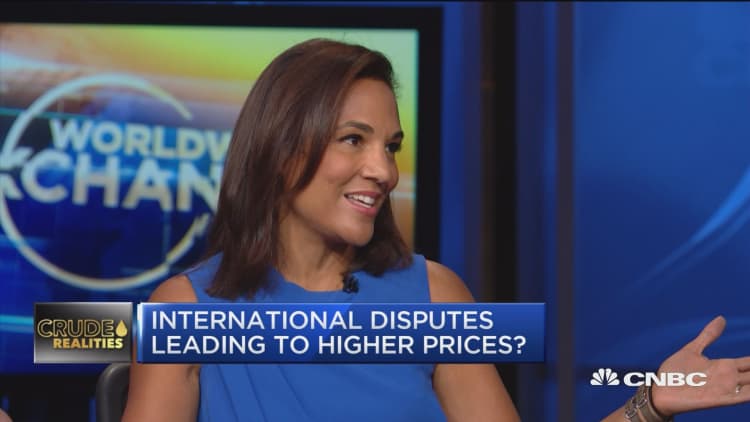Oil prices rose on Thursday, extending gains on growing evidence of disruptions to crude supply from Iran and Venezuela and after a fall in U.S. crude inventories.
Brent has risen by almost 10 percent over the past two weeks on widespread perceptions that the global oil market is tightening and could run short in the next few months as U.S. sanctions restrict crude exports from Iran.
"There are a lot of supportive factors here," said John Kilduff, a partner at Again Capital Management in New York.
Benchmark Brent crude oil was up 56 cents a barrel at $77.70 by 2:29 p.m. ET. U.S. light crude ended Thursday's session up 74 cents, or 1.1 percent, at $70.25, the highest closing price in six weeks.
"The oil market is once again tightening," said Giovanni Staunovo, analyst at Swiss bank UBS in Zurich. "Iranian oil export declines are already visible well in advance of U.S. oil-related sanctions, which enter into force in November."

Iranian crude exports will likely drop to just over 2 million barrels per day (bpd) in August, versus a peak of 3.1 million bpd in April, as importers bow to American pressure to cut orders.
The Organization of the Petroleum Exporting Countries, in which Iran is the third-biggest producer, will discuss in December whether it can compensate for a sudden drop in Iranian supply after sanctions start in November, the head of Iraq's state oil marketer SOMO, Alaa al-Yasiri, said on Wednesday.
Crude exports from crisis-struck OPEC member Venezuela have also fallen sharply, halving in recent years to around 1 million bpd.
Official U.S. oil inventory data on Wednesday also helped the bullish trend.
U.S. commercial crude inventories fell by 2.6 million barrels in the week to Aug. 24, to 405.79 million barrels, more than forecast, the Energy Information Administration said.
U.S. production was flat from the previous week's record of 11 million bpd.
The market pared gains slightly in morning trade after information provider Genscape said inventories at the delivery hub at Cushing, Oklahoma had risen 101,433 barrels since Aug. 24, traders said.
The International Energy Agency (IEA) has warned of a tightening market towards the end of the year, due to a combination of falling supply in countries such as Iran and Venezuela, and strong demand especially in Asia.
"Definitely there are some worries that oil markets can tighten towards the end of this year," IEA Executive Director Fatih Birol told Reuters on Wednesday.

BNP Paribas global oil strategist Harry Tchilinguirian saw a combination of supply risks.
"As Iranian oil exports are lost to the market, Venezuelan production continues to decline, Angola struggles to maintain output and Libya is subject to episodic outages," he told Reuters Global Oil Forum.
"The path of least resistance (for prices), at least in our view, is up."
Still, the market could face renewed headwinds from uncertainty about growth in emerging markets, said Again Capital's Kilduff. "What's been holding us back is demand concerns - we thought Argentina was put to bed and it is a detracting factor."
Argentina's central bank on Thursday yanked up its benchmark interest rate to 60 percent from 45 percent in a bid to control inflation running at more than 31 percent as the country's currency plummeted 15.6 percent to a record low 39 pesos per U.S. dollar.
— CNBC's Tom DiChristopher contributed to this report.

